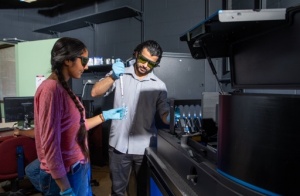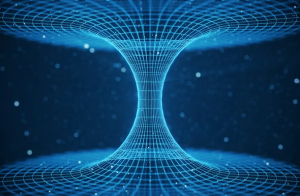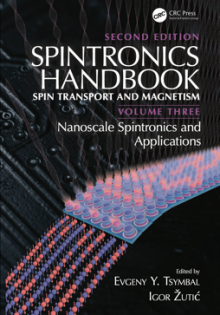Research News

The Many Phases of Living Matter
Priya Banerjee, PhD
New research led by Prof. Priya Banerjee and his team at the University at Buffalo advances our understanding of molecular driving forces of phase transition in living systems. Living cells contain an intriguing class of micron-scale structures that are best known as biomolecular condensates. Past studies have established that some cellular proteins and nucleic acids undergo liquid-liquid phase transition into condensates of different kind that helps cells to reduce noise in biological signal processing and control. However, the physical rules that govern this phenomenon as well as the structure and dynamics of the biomolecular condensates remain largely enigmatic. In 2019, Banerjee’s group published four papers (one of which is in collaboration with colleagues at University at California, San Diego) where the group reported development of new optical tools and its application to characterize biomolecular condensates spanning nano-to-micronscale. These reports collectively reveal that a delicate interplay between entropic forces due to molecular crowding and sequence-encoded inter-chain interactions controls the phase behavior and fluid dynamics of condensates formed by associative biological polymers (i.e., proteins/RNA/DNA). These studies are highlighted by multiple press releases by UB and other media outlets (UB Now March 2019, August 2019, October 2019, and Nature Scientific Reports). One key feature of the findings reported by Banerjee’s research group is the molecular code driving a glassy transition in certain biomolecular condensates. The group is now actively studying this phenomenon of ageing of condensates that play key roles in the development and progression of Amyotrophic lateral sclerosis (ALS), also known as motor neuron disease.
Graduate students Taranpreet Kaur (left) and Ibraheem Alshareedah prepare a microfluidic flow chamber for single-molecule experiments. Microfluidics allow investigation of protein droplets under optical traps — a technique used to conduct research in protein phase transition in Banerjee Lab. They are recipients of the John Ho and Martha Leung Scholarship due to their exceptional performance in graduate research and scholarly activity.

Observing a Wormhole
Dejan Stojkovic, PhD
The Schwarzschild solution of Einstein’s equations that describes black holes was derived in 1916. It is a very unusual solution – it has an event horizon and singularity at the center. For decades, scientists thought that black holes were just some pathological solutions of General Relativity, which have nothing to do with nature. It took people 50 years to start talking about black holes seriously – John Wheeler coined the term “black hole” in 1960s. Now we see black holes everywhere around the universe. Wormholes are also legitimate solutions of Einstein’s equations - though a bit unusual for some people’s taste - that connect two different parts of the universe, or two different universes altogether. Knowing what happened with black holes, I would not be too much surprised if in not-too-distant future we find some wormhole candidates. Small primordial wormholes are more likely to form, since negative energy which is needed to keep them open is more likely to be produced in early universe when large fluctuations in energy density are common, however they might be short lived. It is also conceivable that a wormhole could be formed in gravitational collapse, though we are still lacking an exact description of this process. In our recent publication (Physical Review D 100, 083513), we considered an interesting and intriguing possibility that a supermassive black hole at the center of our galaxy is actually a wormhole. Our wormhole solution looks like a BH from outside. One would notice that the wormhole mouth is not an event horizon only when passing through it. If a wormhole does exist at the center of our galaxy, nearby stars would be influenced by the gravity of stars at the other end of the passage. As a result, it would be possible to detect the presence of a wormhole by searching for small deviations in the expected orbit of stars near it. The best candidate is the star named S2 whose orbit has been very well studied by astronomers in the past 20 years. We know the motion of S2 with the current acceleration precision of 10-4 m/s2. Once the precision reaches 10-6 m/s2, perhaps within a decade, we will be able to exclude the most plausible source of perturbations on the other side – a few solar mass stars. If by any chance the predicted deviations are observed, there would be still a lot of work needed to perform detailed modeling and exclude other more conservative sources of perturbations (for example smaller black holes on our side).

Thin Films with Tantalizing Electronic Properties
Hao Zeng, PhD
Semiconductor materials are considered the backbone of modern society. They are widely used in electronics, solid state lasers, light emitting diodes, solar cells, optical sensors, etc. While the history of semiconductors dates back to early nineteenth century, today only a handful of materials are used industrially. Recently, chalcogenide perovskite has emerged as a novel class of semiconductors promising remarkable electronic and optical properties. This is a compound family with a chemical formula of ABX3, where A and B are both cations and X is a sulfur or selenium element. With funding from the National Science Foundation and Department of Energy SunShot program, Prof. Hao Zeng’s group aims to realize high-quality chalcogenide perovskite thin films for high efficiency and low cost solar cells and light emitting diodes. In a recent publication (Nano Energy, Vol. 68, February 2020, 104317), graduate students Xiucheng Wei and Haolei Hui and collaborators presented the optical and electronic properties of the first thin film of barium zirconium sulfide (BaZrS3) ever made. They showed that the optical absorption of this material is exceptionally strong, higher than that of any material used in today’s solar cells. The films also exhibit promising electronic transport properties. These materials are further highly stable against moisture and heat, and consist of earth abundant and non-toxic elements. The group aims to demonstrate thin film and device fabrication using industrial scalable processes in the next step. For more information, see the UB News release.

Putting Spin Into Lasers
Igor Žutić, PhD and Gaofeng Xu
Lasers provide a myriad of applications and model systems to study nonequilibrium and cooperative phenomena. Novel concepts in lasers then have potential to lead to both new applications and fundamental insights, as recognized by the 2018 Nobel Prize in Physics. One of the striking challenges for innovation in lasers is to address the explosive growth of global internet traffic. Short-range and energy-efficient optical communication networks provide most of the communication bandwidth to secure the digital revolution. Key devices for high-speed optical interconnects in server farms are intensity-modulated semiconductor lasers. The operation of such lasers and the resulting information transfer can be understood in close analogy with a damped driven harmonic oscillator. To ensure the maximum bandwidth, a useful frequency range where the signal is sufficiently strong, we need to modulate the harmonic oscillator as fast as possible. However, when it is driven faster than its resonant frequency, its response quickly falls and the displacement becomes negligible. Analogously, by modulating the laser faster than its maximum resonant frequency of about 20 GHz the emitted light intensity variation becomes negligibly small. By putting spin into lasers, using magnetic contacts or circularly-polarized light, through conservation of angular momentum the spin of carriers is transferred to photons and the emitted light becomes circularly polarized. Surprisingly, we have predicted that the resonant frequency for the polarization of the emitted light can be much higher than for the emitted intensity, allowing ultrafast modulation of such spin-lasers. In collaboration with experimentalists in Germany, led by Dr. Nils Gerhard from Ruhr University at Bochum, who with his collaborators has frequently visited UB, we have demonstrated a remarkable improvement in which, after putting spin into lasers, the polarization of light can be modulated above 200 GHz, an order of magnitude faster than the intensity modulation in the best conventional lasers! This work was published in Nature 568, 212 (2019) and its illustration below was featured on the cover page of the Spintronic Handbook. Surprisingly, this ultrafast operation of the spin-laser relies on a large anisotropy of the refractive index—birefringence, viewed as detrimental in conventional lasers. To achieve a large birefringence, which is directly related to the oscillation frequency of the emission polarization, it was important to induce strain and, as depicted, deform the lasers. Our results overcome the key speed limitations of conventional lasers and offer an intriguing prospect for the next generation of low-energy ultrafast optical communication.